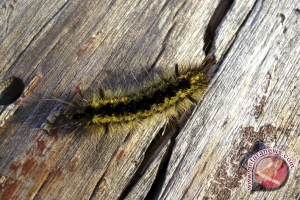Caterpillar outbreak: Another black swan?
Dyna Rochmyaningsih, Jakarta | Thu, 04/14/2011 8:00 AM | Opinion
A caterpillar outbreak has recently spread across 15 districts in Java, Bali, East Lombok, Bekasi (West Java) and lastly in West Jakarta. Thousands and thousands of caterpillars, with their stingy hairs, unconsciously terrorize the residents of areas they invade.
...
The first outbreak was in Probolinggo, East Java, and then it moved to the western part of the island, to Jombang, and Kendal in Central Java, and then to Bekasi in West Java, but then it moved backward to Bali, jumped to East Lombok and now has been reported in Jakarta.
Interestingly, different regions were invaded by different species of caterpillars. Probolinggo was invaded by Lymantria atemeles and Arctornis sp, Banyuwangi was invaded by Dasychira inclusa, and certainly different species invaded other areas.
It is suspected that most of them are from the Lymantriidae family, which includes the Tussock Moth that is covered in irritating hairs during its larval stage.
Our local scientist, Supata, from Gajah Mada University, says no one is sure what triggers such massive outbreaks. As explained above, several circumstances influence the phenomenon. But I think this phenomenon is an example of a ?Black Swan? event, a term that was developed by economist and philosopher Nassim Taleb.
Full text:
Dyna Rochmyaningsih, Jakarta | Thu, 04/14/2011 8:00 AM | Opinion
A caterpillar outbreak has recently spread across 15 districts in Java, Bali, East Lombok, Bekasi (West Java) and lastly in West Jakarta. Thousands and thousands of caterpillars, with their stingy hairs, unconsciously terrorize the residents of areas they invade.
...
The first outbreak was in Probolinggo, East Java, and then it moved to the western part of the island, to Jombang, and Kendal in Central Java, and then to Bekasi in West Java, but then it moved backward to Bali, jumped to East Lombok and now has been reported in Jakarta.
Interestingly, different regions were invaded by different species of caterpillars. Probolinggo was invaded by Lymantria atemeles and Arctornis sp, Banyuwangi was invaded by Dasychira inclusa, and certainly different species invaded other areas.
It is suspected that most of them are from the Lymantriidae family, which includes the Tussock Moth that is covered in irritating hairs during its larval stage.
Our local scientist, Supata, from Gajah Mada University, says no one is sure what triggers such massive outbreaks. As explained above, several circumstances influence the phenomenon. But I think this phenomenon is an example of a ?Black Swan? event, a term that was developed by economist and philosopher Nassim Taleb.
Full text:




Comment